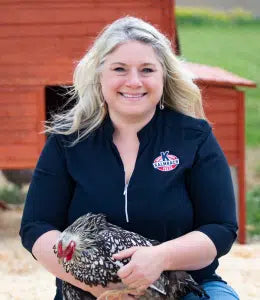Nutrition for Backyard Chickens

If you peruse your local chicken feed store shelves, you may notice that there are quite a few poultry options available. Sometimes it can be hard to know which product to choose. Today we are going to discuss some of the specific nutrient requirements of laying hens and break down how to choose the best option for your entire flock.
Stages of Chicken Growth
The first two things to consider are the age of the birds and the stage of production. Most folks who keep backyard birds are going to be familiar with three main stages – starter phase, grower phase, and layer phase. For ease of feeding, it is quite common for starter and grower feeds to be in combination. If your birds are less than 4 months old, they should be consuming a complete starter/grower feed. These feeds have all the nutrients that young birds need to produce feathers, grow, and develop their immune systems. If you have laying hens and they are at least 4 months old, your birds should be consuming the best chicken feed. If you have a mix of laying hens in different stages of life OR you have roosters in your flock, keep reading!
Chicken Nutrition
The laying phase is absolutely the most popular phase for most people that keep backyard poultry. There are a number of reasons why someone would choose to keep backyard poultry but eggs are almost always near the top of the list. A high-quality COMPLETE layer feed is essential to keeping your birds in peak physical condition so that they can produce beautiful, wholesome eggs for you and your family.
If you recall from our previous article on The Lowdown on Leftovers, a “complete feed” simply means that the product inside that bag contains all of the nutrients, in the correct proportions, that your birds need to perform well. If a complete feed is the only thing that your birds ever eat, it would be sufficient.
If you compare the tag for a starter/grower feed with the tag for a layer feed, you probably won’t be blown away by the differences that you see. However, there should be one nutrient that really stands out – CALCIUM! The calcium in a complete layer feed should be 3-4x higher than the calcium in a starter/grower feed. Hens need a lot of calcium to produce high quality egg shells. It takes a little over 24 hours for a single egg to be formed. Fifteen of those hours are spent on eggshell formation! It is an extremely important step for the hen. In fact, when all is said and done, the egg shell is composed of over 94% calcium carbonate. Since a hen in peak production is producing one egg every single day, you can imagine that her calcium needs are very high. All of our Kalmbach Feeds complete layer feeds (16% Layer, 17% Layer, Hi OmEGGa®, Full Plume™ Feathering Feed, and Henhouse Reserve®) are excellent sources of ALL of the nutrients your laying hens need to stay in peak physical condition and produce high-quality, beautiful eggs.
However, laying hens are not the only backyard chicken anymore. In the past, we have concentrated on laying hens. Eggs were the #1 priority. Any roosters in the flock were just along for the ride and any non-producing hens quickly found their way into the soup pot. Today, as more and more consumers start to think of their poultry as pets, we know that we need to consider the nutrient needs of our roosters and non-producing hens too.
Do you have roosters or retired hens as part of your flock? Roosters and non-producing poultry do not have the same calcium requirements as a laying hen. If these birds are part of your flock, that can often complicate our feed choices. There are options. It is quite common for backyard poultry keepers to use a flock feed like 20% Flock Maker™ or 16% Flock Maintainer™ along with a separate calcium source like oyster shells or limestone chips. Some poultry keepers will choose to use two feeds – a high quality complete layer feed for the hens and 16% Flock Maintainer for the other types of poultry. These are both good compromises but do require more space and management from you.
If you love using a complete layer feed for your hens but you’re worried about feeding excess calcium to your roosters and retired hens, you may want to consider a product like Henhouse Reserve®. Henhouse Reserve® is unique because it is a textured complete feed composed of vegetables, grains, seeds, and nutrient-rich pellets. It also contains multiple, independent sources of calcium. This feeding strategy gives your hens all of the calcium they need to produce high-quality eggs but allows your roosters and non-producing poultry to self-regulate how much calcium they consume. It works great for backyard poultry keepers that are limited on space or do not want to maintain two different types of feed.
Keeping poultry is such a wonderful experience and the rewards are many! At Kalmbach Feeds, we are always here to help. If you have any questions about the nutrient needs of your birds, feed options, or general poultry keeping, please let us know.
